The BlackBerry PlayBook Review
by Anand Lal Shimpi on April 13, 2011 9:00 PM EST- Posted in
- Tablets
- Smartphones
- RIM
- BlackBerry
- PlayBook
- Mobile
I suppose it's fitting that I should be the one to write our PlayBook review. Before Android and the iPhone, there were two mobile platforms/devices that I was hugely fond of: the Palm V and my BlackBerry. In fact, it wasn't until the iPhone that I finally let go of my last BlackBerry - moving on from the email era into the smartphone age.
Today's BlackBerry is of course very different than the devices I used in college. And the PlayBook is unlike anything RIM has ever done.
I don't believe any tablet maker has perfected the formula just yet. I made that abundantly clear in our review of the iPad 2. While you can't argue that Apple is the forerunner in the smartphone based tablet space, over the long term I still believe this is anyone's game. Remember, the leaders in the early days of the PC industry weren't the ones who ultimately dominated the mature market.
What follows is our review of RIM's first attempt at building a tablet. The PlayBook is far from perfect, but there's a foundation here that can be built upon if RIM has a good roadmap and good execution. And if you're a BlackBerry user, there's a lot of synergy to exploit.
| BlackBerry PlayBook Pricing Comparison | |||||
| 16GB | 32GB | 64GB | |||
| WiFi | $499 | $599 | $699 | ||
Let's get to it.
The Hardware
If we view the primary difference between the first and second generation of smartphone based tablets as being ergonomics and performance, the PlayBook falls squarely in between the two.
At 10mm thick the PlayBook (7-inch display) is more iPad 1 (9.7-inch) or Xoom (10.1-inch) than iPad 2 or Galaxy Tab 8.9, but what RIM lacks in thinness it makes up for in overall size. The PlayBook is an almost-pocketable tablet. Bigger than the 5-inch Streak and even bigger than the 7-inch Galaxy Tab, the PlayBook isn't a pain to port around. The PlayBook is small enough to snugly fit inside the outer pocket of a long men's winter coat or a lady's purse. While I definitely don't carry my iPad everywhere, if it were more functional I could see carrying the PlayBook with me more often than any other tablet.
The PlayBook's styling is modest, even for BlackBerry standards. The front has a single BlackBerry logo along the bottom bezel and a visible camera lens but that's it. Around back you've got RIM's logo, a larger lens for the rear-facing 5MP camera sensor and a sea of black.
The only buttons on the device are along the top of the PlayBook: power, volume down, pause/play and volume up. The power button is flush with the surface of the PlayBook's edge. You basically need a pointy finger nail (which I typically don't have) to press it easily and as a result the power button was pretty much useless to me. If you can manage to hit it the power button will lock the PlayBook, otherwise you'll have to leave the tablet idle until it automatically goes into standby. RIM tells me that final versions of the PlayBook will have this power button raised by 0.8mm, enough to make it easily clickable.
Press and hold the power button and you'll be greeted with a PC-like choice to either power off the PlayBook or restart it. I'm not sure how frequently RIM expects you to do the latter, but when testing it's a nice feature to have.
The volume up/down buttons work as expected, although the volume level itself doesn't seem to be very linear. There's a single 1/8" headphone jack up top, near a port for the PlayBook's microphone.
The PlayBook features a pair of pretty loud stereo speakers on the front of the device. Being used to the iPad's single speaker, the PlayBook's two speakers are nice.
Charging is always an issue on these USB devices. You can take Apple's approach and charge over USB, which unfortunately can take a while to fill up a tablet's battery. You also run into issues with older computers that don't support the USB Charging spec, resulting in charging-only-while-sleeping like the iPad. Then there's Motorola's approach with the Xoom where you don't charge over USB but have a dedicated port for an AC adapter. Charging times are significantly reduced but now you need to carry around an extra adapter with you wherever you go. RIM arrived at what's quite possibly the best solution. The PlayBook will charge over USB and it also features a higher amperage quick-charge port for use with some of its accessories.
The battery is of course not removable and there's no USB port or SD card reader.
The Form Factor
The PlayBook is only slightly larger than Samsung's 7-inch Galaxy Tab and maintains the same 7-inch screen size (albeit with a functional border around the screen). Given my complaints about current tablets not being incredibly portable compared to a smartphone, you'd think that I'd love the PlayBook's form factor. To be honest, for portability, I do.
| Tablet Specification Comparison | |||||
| Apple iPad 2 | BlackBerry PlayBook | Motorola Xoom | |||
| Dimensions | 241.2mm x 185.7mm x 8.8mm | 194mm x 130mm x 10mm | 249.1mm x 167.8mm x 12.9mm | ||
| Display | 9.7-inch 1024 x 768 | 7-inch 1024 x 600 | 10.1-inch 1280 x 800 | ||
| Weight | 601g (WiFi only) | 425g | 730g | ||
| Processor | 1GHz Apple A5 (2 x Cortex A9) | 1GHz TI OMAP 4430 (2 x Cortex A9) | 1GHz NVIDIA Tegra 2 (2 x Cortex A9) | ||
| Memory | 512MB | 1GB | 1GB | ||
| Storage | 16GB up to 64GB | 16GB up to 64GB | 32GB + microSD card | ||
| Pricing | $499 up to $829 | $499 up to $699 | $599 - $799 | ||
While I'm almost never tempted to bring the iPad with me when I'm going around town, the PlayBook is a far easier sell. It's almost pocketable (and actually pocketable if I'm wearing a big jacket) and isn't too heavy.
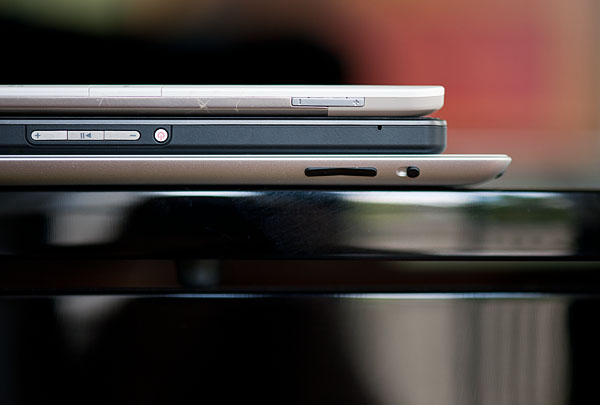
From top to bottom: Amazon Kindle 2, BlackBerry PlayBook, Apple iPad 2
Even when I'm not out and about, the PlayBook is quite usable as a content consumption device. In portrait mode fonts are a bit too small for me to read comfortably on the couch but in landscape it works well as a reddit browsing machine.
It's in the couch-lounging usage model that the PlayBook does fall short of the iPad or Xoom. But in terms of portability the PlayBook is clearly a much better balance of functionality and mobility. If you read between the lines you'll come to the same conclusion I have: neither the PlayBook nor the iPad is the perfect form factor for a tablet. Further more, I'm not sure there is a single perfect tablet form factor.
Apple tends to be a one-size-fits-all company when it comes to iOS. You want a smartphone? That'll be a 3.5-inch screen on an iPhone. Want a tablet? 9.7-inch iPad. It's interesting given how carefully Apple selected its four notebook sizes: 11, 13, 15 and 17-inches.

Clockwise: Apple iPad 2, Amazon Kindle 2, BlackBerry PlayBook in Convertible Case
Ultimately I don't think tablets will fall into the one-size-fits-all category. Instead I believe they're ultimately headed for some sort of a convergence with netbooks or notebooks. Today that's difficult to see because they lack a common hardware ISA, OS and even apps, but you don't have to look too far into the future to see those problems going away.
While I appreciate the PlayBook's portability and would definitely carry it around more than an iPad, it's not as nice to use laying back on a couch. The screen is too small to comfortably read in portrait mode and even in landscape things can get a bit cramped.
RIM's market research shows a clear preference for portability, hence the PlayBook's introductory 7-inch form factor. However RIM also pointed out that the BlackBerry comes in all shapes and sizes, indicating that the PlayBook would ultimately be available in different form factors as well. RIM also indicated that the 7-inch PlayBook may not be the smallest size offered either. Clearly RIM views the tablet market much like the notebook market: there will be ultraportables and there will be workhorses, with tons of choice in between. The 7-inch PlayBook is merely a starting point. Assuming RIM can fund the projects, we'll likely see both larger and smaller siblings in the future.


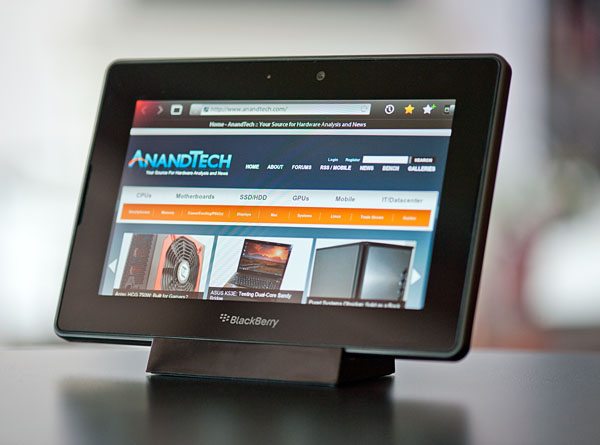
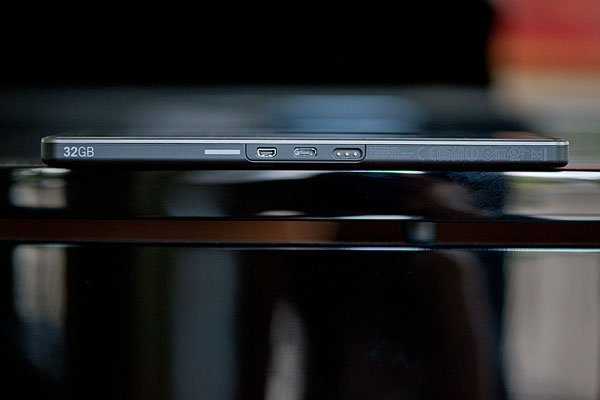
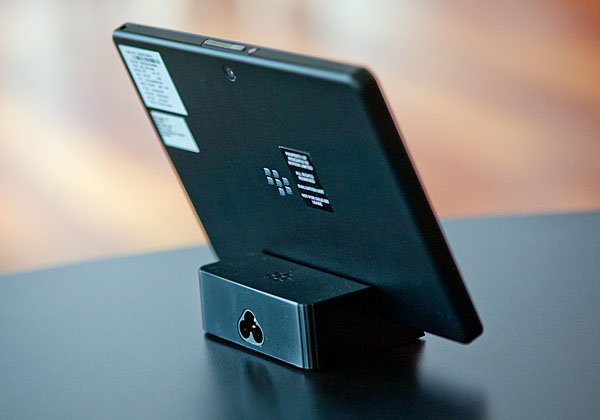
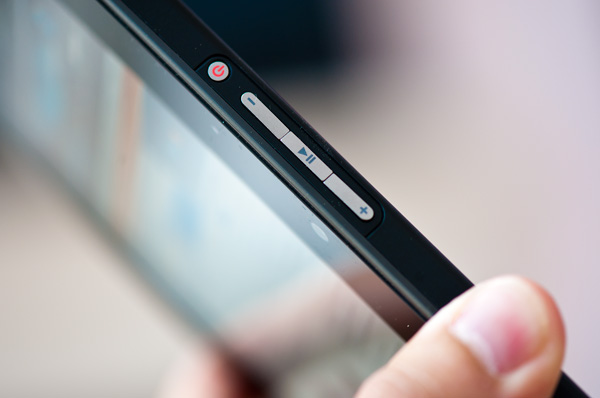
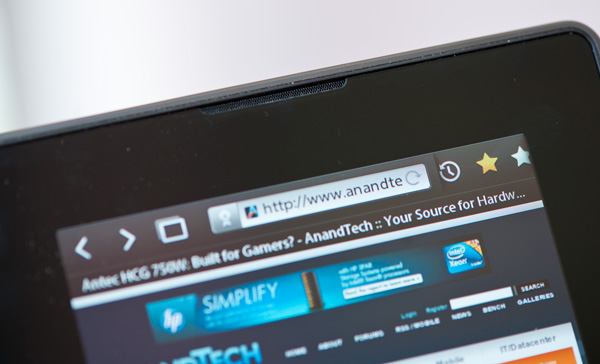








77 Comments
View All Comments
Anand Lal Shimpi - Thursday, April 14, 2011 - link
You're very right, clarified! :)Take care,
Anand
Targon - Thursday, April 14, 2011 - link
I will note that the idea of using gestures that originate in the bezel seems to be an evolution of the Palm(now owned by HP) gesture area on the Palm Pre and the other WebOS based smartphones. Yes, the tablet lets you use any bezel, but as I said, this is an evolution of the concept that Palm implemented with the gesture area.Since the HP Touchpad will not have a dedicated gesture area, it will be interesting to see how things play out going forward in the tablet space.
melgross - Thursday, April 14, 2011 - link
But do the gestures really extend into the bezel area, or do they really just start at the first pixel your finger encounters when swiping from beyond the edge of the screen? I think it's the latter. Swiping from the bezel just insures that your finger will be detected hitting that first pixel in the screen at the edge, which tells the OS that it's a special "bezel" gesture.Maybe I'm wrong, but it makes sense to me that that's how it works, then thinking that the entire bezel is gesture enabled with sensors, though it's possible.
Perhaps Anand, can help here.
AnitaPeterson - Thursday, April 14, 2011 - link
Mate, you wrote so many pages, but eschewed some of the most important questions.1) You discuss the screen, but make no mention of the technology - is it IPS? is it TN? As for the surface - is it polycarbonate? is it GorillaGlass?
2) You discuss the USB, but make no mention of crucial use - does the Playbook have USB host capabilities? In other words, can you connect an external HDD to it (whether self-powered or externally powered) and read files from it?
3) Since we mention USB and external storage, how about a peep about SD card support? Seriously... a review with nary a mention of additional/expandable storage?
4) Why are you comparing it with the iPad and the Xoom, instead of comparing it with the only other real, usable device in its size class, namely the Galaxy Tab??? The Playbook is not for people who want large devices, who can get an iPad... Is it not clear that the size is one of the biggest factors at play here? You mention the Galaxy Tab exactly once, and make an intriguing statement that the Playbook is a bit larger... but when it comes to pictures, again you compare it with the Kindle (!??) and the iPad. Eh? the Kindle???
I'm sorry to be harsh, but this is a rush job... just like the Playbook itself.
Lepton87 - Thursday, April 14, 2011 - link
Have you even read the review? It answers two of your three questions. The tablet doesn't have an SD card slot and it doesn't have an USB port either. Your fist question still stands, I'm also curious what panel technology its screen uses.Pessimism - Thursday, April 14, 2011 - link
Incorrect. It does have a USB port, and the review specifically states this when discussing available charging options. The poster was asking whether its possible to use a male-male USB cable to connect mass storage to it.Pessimism - Thursday, April 14, 2011 - link
of hearing everyone whine and complain about lack of matroska support. matroska has NO STANDING outside anime nuts who can't wrap their brains around a second file to contain subtitles. matroska is a tiny speck with no corporate backing, no manufacturer is going to dedicate development time or die space to support it.Penti - Friday, April 15, 2011 - link
Actually it has pretty good manufacturer standing now, it's supported by Sonic Solutions/divx, ArcSoft, CoreCodec and all the serious chipset manufacturers of media player chipsets and STB solutions. As well as support on BD-players and televisions coming along. Nero also has support for it btw. Even boxes like the Roku now supports local playback and MKV. (Roku XDS with USB) Also there is no die space needed it's just a container. Software is all that's needed. Nokia also added MKV support in Symbian^3.DesktopMan - Thursday, April 14, 2011 - link
"As you'll see in our video tests, the PlayBook is the first ARM based tablet we've used that can decode a 1080p H.264 High Profile video stream."I believe the Hard Kernel ODROID-A was the first on the market (though in limited availability), as it's using the Samsung Exynos 4210 SOC. Would be great to see a test of that, to see how well the Exynos drives a tablet. I have high hopes for it.
NCM - Thursday, April 14, 2011 - link
The ability to handle 1080p H.264 is technically impressive, but I have to wonder about its relevance to the intended business market. One might like that at home, although even there it seems to me to be a party trick.And speaking of business use, the idea of using webmail for that is of course a joke, especially on a mobile device that won't always have a live net connection. I'm sure we all understand that this really is a software timing problem, but still, a bit of an embarrassment for RIM.
I'm not enticed by the 7" screen size, which is too big for the pocket and seems too small for good reading functionality. But one of the things we're seeing from the iPad's success is that people are coming up with their own uses for tablets, uses that weren't necessarily envisioned before they hit the market. Maybe that'll happen with the 7" devices too?